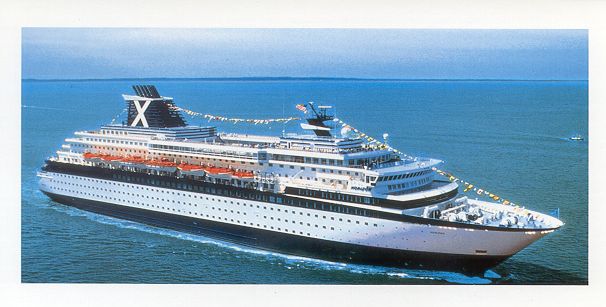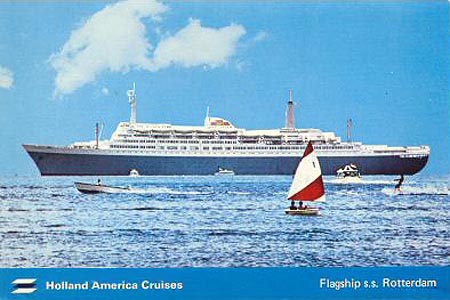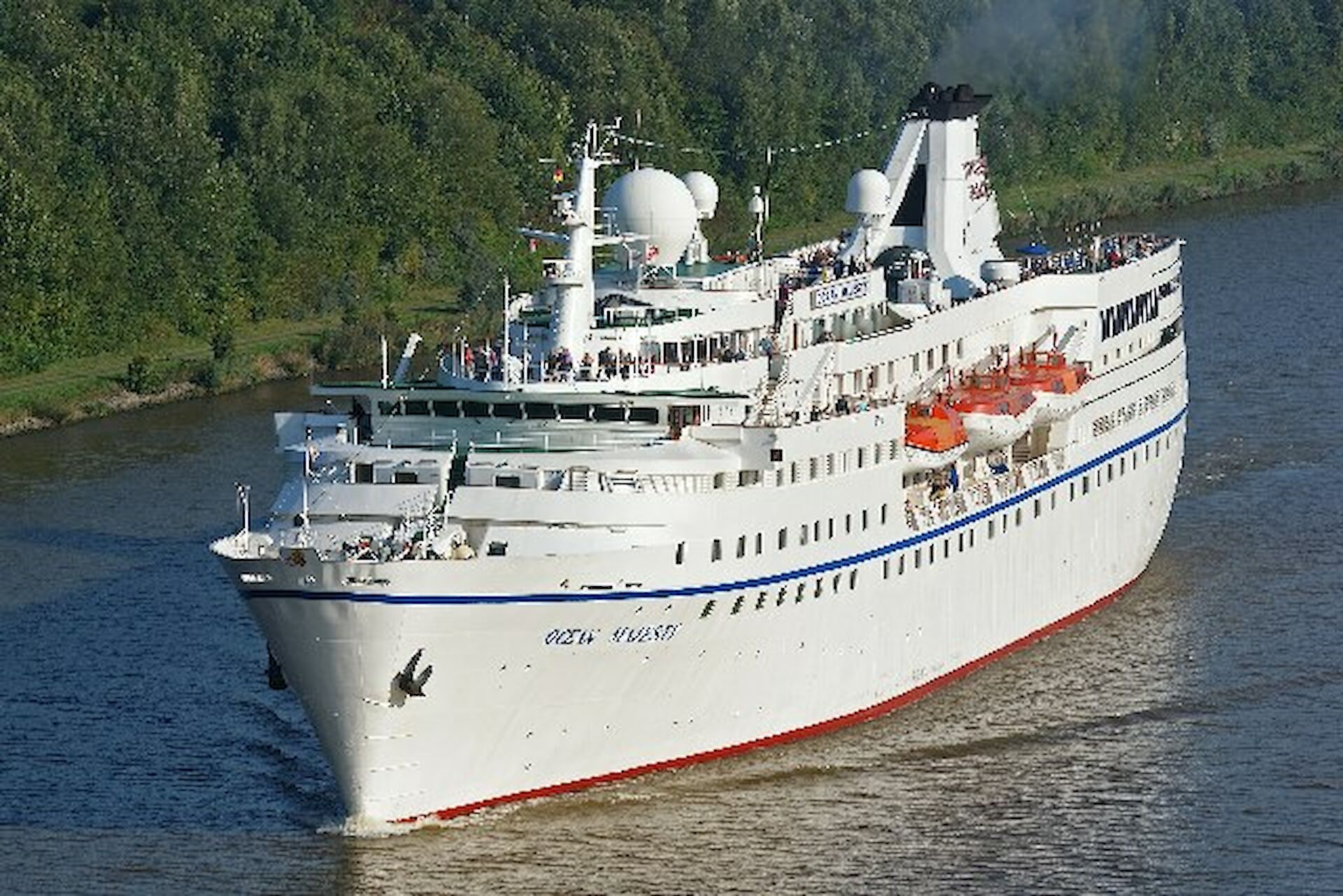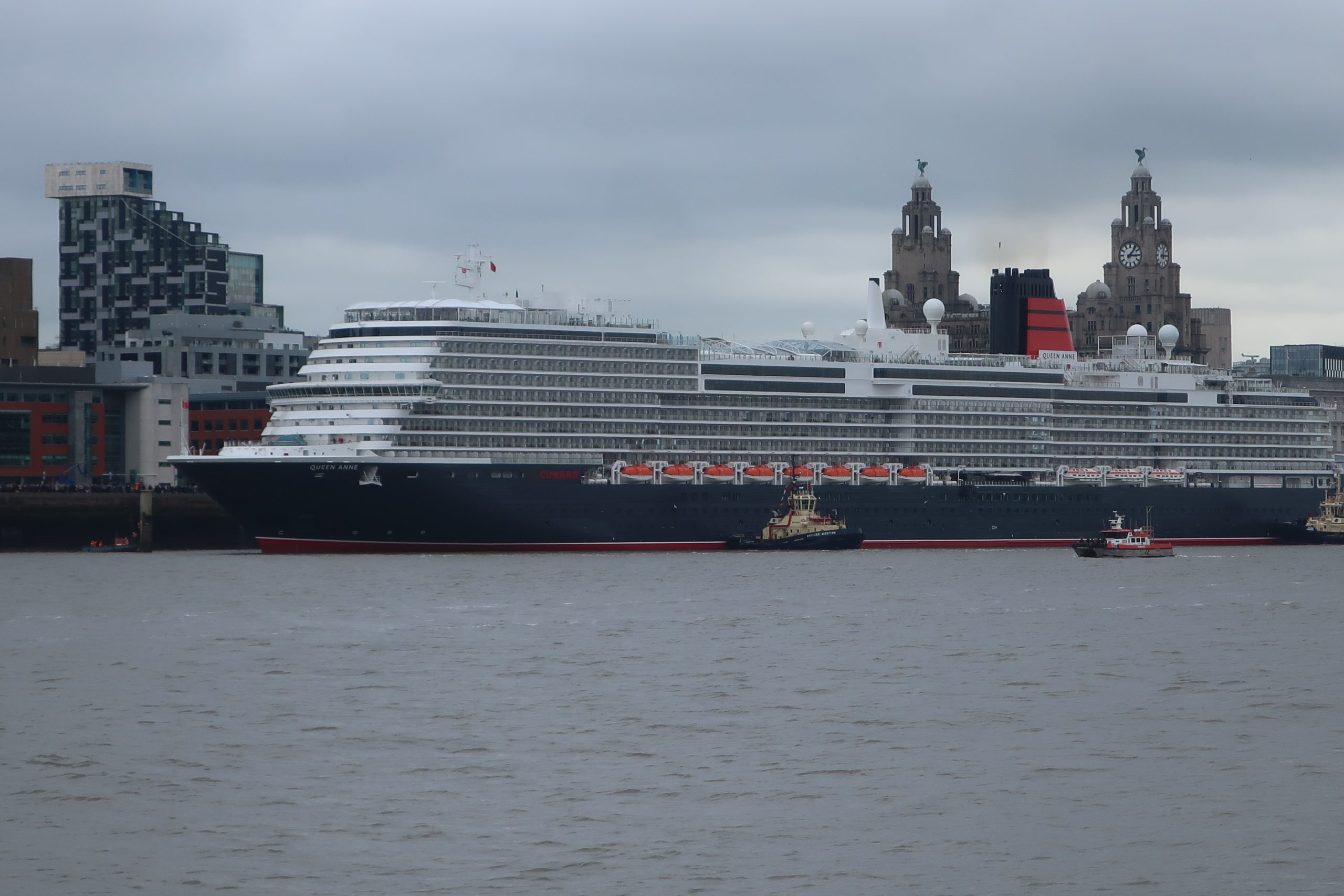Last January (2019) I visited the former Cunard transatlantic liner Queen Elizabeth 2 in Dubai. She is a hotel ship nowadays and is located in Port Rashid directly opposite to the pier where cruise ships dock. Dubai being a popular cruise hub regularly receives 4 or 5 vessels a day and I happened to see Pullmantur’s Horizon calling. She was docked with a couple of other ships, and was absolutely dwarfed by these mega ships from Costa, MSC, Cunard etc. It shows the spectacular growth ships and the entire cruise industry for that matter of the last 30 years.
Horizon was built in 1990, an era when balconies did not play a significant role and neither did all kinds of spectacular facilities like zip-lines, rock-climbing, ice-skating tracks and what have you.
The exterior of the ship was designed by John Bannenberg and her interiors had been designed by Michael Katsourakis (Athens) and John McNeece (London).

In the 70’s, 80’s and 90’s, the Greek passenger shipping line Chandris Cruises which had started operating liners on the run from Europe to Australia ferrying immigrants and later tourists to Australia had entered the cruise trade when passenger loads in liner service began to decline after more and more passengers switched to flying. They operated old second hand tonnage, like their Ellinis, Britanis, Queen Frederica, The Victoria, Romanza, Romantica etc., all converted liners or ferries. But in the 90’s it became clear that these ships, most of them over half a century old, had become outdated and Chandris decided the company would be split in two: Chandris Festival and Celebrity Cruises. The older ships would sail for the Festival brand and gradually be phased out, being sold or going to the scrappers. Celebrity Cruises would start with the Meridian (the former Galileo Galilei of Lloyd Triestino of 1963) an older but thoroughly upgraded ship (she had been modernized for 85 million dollars) and a new vessel, the Horizon which had been ordered from Meyer Werft, Germany. Celebrity was marketed from the start as an upmarket luxury line. Chandris planned to dominate the New York-Bermuda route with these two ships.

Chandris had been able to secure a contract for priority berthing in Hamilton, Bermuda, but the local authorities had explicitly demanded luxury vessels to be operated on the week long New York to Bermuda run, as they wanted to continue to promote Bermuda as a luxury destination.
Upon delivery, Horizon measured 46.800 tons, was 207 metres long and 29 meters wide. She could accommodate 1354 passengers in 677 cabins, being looked after by 642 crewmembers. The ship was driven by two propellers, powered by two nine-cylinder and two six-cylinder MAN-diesel engines giving her a service speed of 22 knots. In April 1992 she was followed by a slightly larger sistership, Zenith.

Horizon arrived in New York for the first time in May 1990. For the following two weeks, Celebrity Cruises kept her docked and on on display for travel agents and the public. Next, she was introduced on the run to Bermuda alongside Meridian.
She was praised for her spaciousness, not only her public rooms but also her staterooms averaging more than 170 square feet. Her 2 presidential suites and 18 regular suites being her most luxouriously appointed accommodations.
Her state of the art navigation system and powerful engines allowed Horizon to enter small ports like St. Georges Harbour, Bermuda and in the Caribbean without the help of a tugboat.

Now, Celebrity had secured a major market share of 57% on the run to Bermuda as planned. In comp with RCCL’s Nordic Prince and NCL’s Westward, Horizon sailed this route during the summer months, repositioning to the Caribbean in winter cruising out of San Juan to Martinique, Barbados, St. Lucia, Antigua and St. Thomas.
Apart from an outbreak of Legionnaire’s disease in 1994 which kept her out of service for almost three weeks to be sanitized, her first years in service were quite uneventful. However, she was replaced by her sister Zenith in 1996 when she was used to open up the Alaskan market for Celebrity.
Meanwhile Royal Caribbean International (RCI) was investigating ways to expand like her main competitors Carnival and Norwegian Cruise Lines, and they moved quickly and took over Celebrity Cruises. As Chandris had already phased out their Festival brand after disposing of their older ships, this meaned the end of Chandris presence in the passenger shipping industry where they had been active since 1922. In 2003 Horizon had been shifted to Philadelphia instead of New York for her cruise service to Bermuda and at the same time she had been reflagged from Liberia to the Bahamas.

Being RCI’s partner in Europe plans emerged to move both Horizon and Zenith to First Choice Cruises. But this never came to pass, Horizon stayed in US waters and was used to open up yet another market, that of cruising out of Norfolk, Virginia although she was still employed on the same route to Bermuda on week long cruises.
Celebrity had outgrown ships like Horizon and Zenith at this time. The Century-class ships which came online between 1995 and 1997 followed by yhe 91,000GRT Millenium quartet (2000-2002) offered more facilities and of course economies of scale made these vessels much more profitable.
At last, RCI and First Choice Holidays together establish a new venture, Island Cruises with sailings in the Mediterranean in summer and in winter in South America (Brasil, Argentina). Horizon is chartered out to Island Cruises for six years and is sent to drydock where she receives 59 new cabins, 50 of these with balconies to keep up with the changing times where balconies now are in high demand. Also two new restaurants are added. She starts winter 2005 in South America under a new name: Island Star. The following summer she teams up with fleetmate Island Escape (former Scandinavia, Stardancer, Viking Serenade) cruising from Mallorca.
However, halfway through her intended charter period RCI decides to pull out of their venture with Island Cruises by selling their 50 % stake in the company and after 4 years the charter is terminated.

“Redeploying the Island Star to our expanding Pullmantur fleet allows us to better serve the strategically important Spanish market,” commented Richard Fain, CEO of RCI, explaining why Island Star is now shifted to RCI’s subsidiary Pullmantur, a Spanish cruise operator. Clearly, RCI sees this as a strategically better move to deploy Island Star in the rapidly growing Spanish cruise market. However, Pullmantur wants to expand in mid-America and after renaming her Pacific Dream she is based in Acapulco for a series of 30 cruises along the Mexican Riviera during the second half of 2009.
Alas, the H1N1 – virus (Influenza A) outbreak forces Pullmantur to cancel the entire season and Pacific Dream returns to Europe where she replaces Atlantic Star (former Sitmar FairSky of 1984, the last major pasenger ship with steam turbines). This is short lived however as Pacific Dream develops serious engine problems and she has to be taken out of service for several months for repairs. Atlantic Star comes out of lay-up to stand-in for her. When Pacific Dream finally returns to service she has reverted to her old name of Horizon. She is now chartered by tour operator CVC (the largest group of travel companies in Brasil) in 2010/2011 spending time again in South America. But soon afterwards she is on the move to yet another operator, Croisieres de France, a subsidiary of Pullmantur Cruises (which in turn is owned by RCI). Here (in 2012) she takes over form Bleu de France (ex-Europa 1981, in her early days when sailing for HAPAG-Lloyd rated as the most luxury cruise ship in service) which had just been sold UK cruise operator Saga Cruises. Croisieres de France sends Horizon to the Caribbean where she is based in La Romana, but soon her sister Zenith which has also been chartered to Croisieres de France starting 2014 takes over and Horizon is homeported in Calais where she sails to Scandinavia and the Baltic.

With a new CEO who decides Pullmantur and its subsidiaries need to be more cost effective, a reorganization takes place and Croisieres de France is closed down in 2016. Both Horizon and Zenith return to the Pullman-fleet in 2017. Horizon being of modest size with a low number of cabins to fill is used to open up yet another market, this time she is based for a series of cruises from Dubai where she is stationed in both winters of 2018/2019 and 2019/ 2020.
Horizon when sailing for Pullmantur had the following facilities available for to passengers:
- Restaurants: Le Splendide Restaurant, seating 912, her main dining room, Le Marche Gourmand Buffet Restaurant, Terrace and Grill,
- Casino del Mar,
- Grand Theatre,
- Sapphire Dance Club, Bar Zephir, James Piano Bar & Lounge, Rendez-Vous Lounge, Café Moka,
- Library, Reading Room, Card Room,
- Teen’s Club, Tibu Club (for kids 3-5), Video Arcade,
- Boutique, Internet Center, Conference room, Photo Gallery,
- 2 Swimming Pools, L’Annexe Pool Bar, 2 Jacuzzis,
- 2 Solariums, Fitness Center, Spa del Mar beauty & fitness

Her planned season of cruises in spring and summer 2020 is cancelled because of the pause in operations caused by the COVID-19 pandemic. Unfortunately, this also means the end of Pullmantur Cruises in June 2019 as the company’s reserves are soon drained with all of its ships out of service. RCI owned 49% of the company at this time as 51% were sold in 2016 to Springwater Capital LLC (an investment firm founded in 2002). Two of its ships, Sovereign (1988) and Monarch (1991), once Royal Caribbean’s answer to NCL’s Norway and the first purpose built mega cruise ships were sold to Turkish breakers and they were beached in June/ July in Aliaga, Turkey. Horizon still languishes in Greek waters, in the Aegean Sea near the port of Piraeus. Reportedly she has been sold, but to whom remains unclear.
Horizon was planned to restart cruising in September 2020. But now, with the demise of Pullmantur her future hangs in the balance as most large cruise lines dispose of older less efficient vessels. Maybe she will be picked up by one of the smaller companies…




